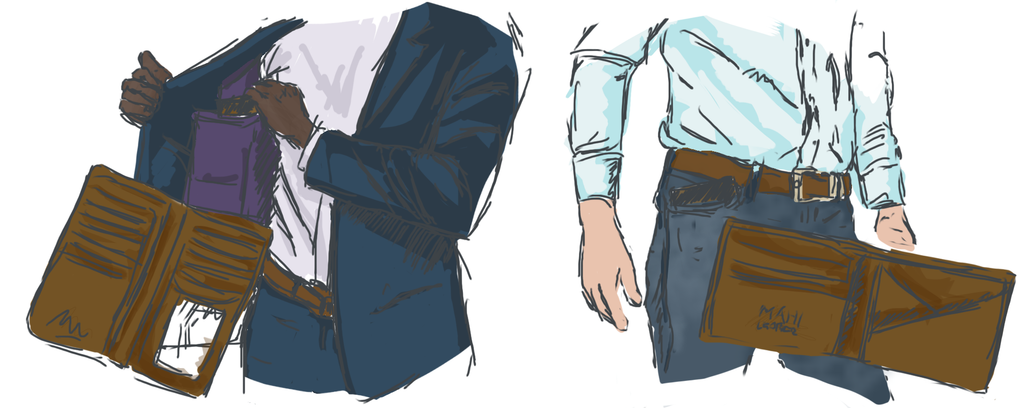The Leather Wallet: History & Origin
Table of Contents

History and Origins of the Wallet
The origin of the word wallet is obscure. Some argue that it derives from the ancient Greek word ‘Kibisis’, which is the word used to describe the sack carried by the god Hermes. 'Wallet' is frequently the translation used to describe the sack in which Perseus carried the severed head of Medusa. The Oxford English Dictionary identifies the word as being of late Medieval origin, at which time it was used to describe ‘a bag for holding possessions’. Shakespeare uses it in this sense when he writes: ‘Time hath my lorde a wallet at his back. Wherein he puts almes for oblivion’. Thus, the early meaning of the word is to describe something that we would recognise as more like a backpack. The transformation of the word wallet to describe a bag for carrying valuables to that describing a flat pouch came with the advent of paper money.

The Chinese were printing paper money in the 12th Century and it is likely that they were using flat pouches to contain it, but it wasn’t until the 17th Century that paper money began to be printed in Europe and the flat wallet came into fashion.
The size of wallets subsequently changed to accommodate changes in the size of paper money. Paper money has got smaller over the centuries and wallets have reduced in size accordingly. Credit cards were introduced in America in the 1950’s and wallets were swiftly modified to accommodate them. The proliferation of store cards and credit cards meant that in the late twentieth century wallets were stuffed to capacity and beyond, but now that it is possible to pay bills on your smartphone, minimalist wallets have become popular. Unlike bags, which are often ostentatious fashion accessories, a wallet is a private and personal item which is usually kept hidden.

Features of the Wallet
Breast wallets, also known as secretary wallets, in which the paper notes can fit unfolded, were the norm up until the 1960’s and suits were designed with an interior breast pocket into which they would fit. The bifold wallet, folds the notes and is consequently much smaller and will fit into the front pocket of a pair of jeans. The trifold wallet allows for the storage of additional cards in a third section and as a result is a fatter wallet. Some wallets incorporate a coin pouch, but coins distend a wallet and ultimately damage the leather.
Wallet vs Card Holder
Traditionally a wallet was used to contain bank notes, tickets and photographs of loved ones. Now that tickets and photographs are stored on phones and almost everything can be paid for by swiping a card, it could be argued that the wallet is obsolete and that a card holder is all that’s required. The leather wallet, however, is a personal possession to which we become attached, the familiar reassuring feel of leather softened by use is something much more appealing than the simple functionality of a card holder.
Giving a Wallet as a Gift
Wallets are often given as gift by loved ones, because they are personal items, men usually only have one at a time and they are kept close to the heart. Personalized wallets are consequently a popular option. Superstition dictates that when a wallet is given as a gift, it should contain money, this will ensure that the wallet is never empty.
How to Protect Your Leather Wallet?
Leather is an extremely strong and durable material, but a wallet is subject to a lot of wear and tear. Part of the enjoyment of owning a leather wallet is the way in which the leather ages and develops a rich patina, however, exposure to strong sunlight and immersion in water will damage leather. With normal usage the occasional wipe with a damp cloth should be sufficient. In extremely dry conditions it may be necessary to apply a conditioner in order to moisturise the leather. Probably the most important thing you can do to prolong the life of your wallet is to avoid over stuffing it. It’s not a bag and you can’t use it as one, if you do you’ll stretch the leather out of shape and break the stitching.
How Long Will a Leather Wallet Last?
This of course depends on how you treat it and the quality of the wallet. If your wallet is made from bonded leather, effectively reconstituted leather, it will last only a fraction of the time that a wallet made of top grain or full grain leather will last. If you use your wallet everyday it’s going to come in for a lot of wear and tear. Stuffing a wallet into a front jeans pocket, which is then bent when you sit down, is going to cause a lot more damage than slipping it into the silk lining of your suit. Research suggests that on average, men keep their wallets for about seven years.
What do You do if Your Wallet Gets Wet?
You drop your leather wallet in the pool or forget it’s in your jeans and it goes in the washing machine. Does it mean you’ll need to buy a new one? Not if you take you time to dry it slowly. If you use a hair dryer, or put it in the oven or put it on a radiator, the leather will crack and the wallet will be ruined, but it you stuff it with tissue and replace it when it becomes damp and you place the wallet in a warm but not hot place, you should be able to bring your dear friend back to life. When the wallet has completely dried out apply some leather conditioner or saddle soap to replenish the oils which have been lost.












